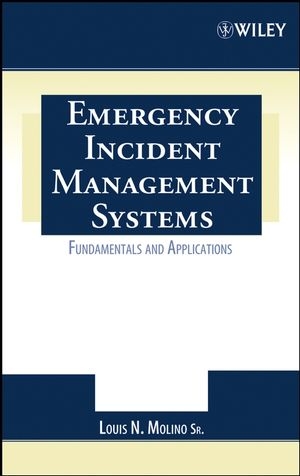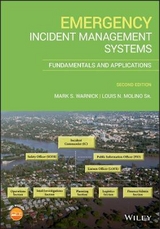
Emergency Incident Management Systems
John Wiley & Sons Inc (Verlag)
978-0-471-45564-6 (ISBN)
- Titel erscheint in neuer Auflage
- Artikel merken
A "street smart" look atincident management in all its permutations Incident Management Systems (IMS) provide the means by which to coordinate the efforts of individual agencies in order to stabilize an incident and protect life, property, and the environment. Born from the FireScope project of the late 1960s, which was developed in response to the major wildfires that regularly plagued Southern California, these systems have evolved with many similarities and certain fundamental differences. Emergency Incident Management Systems: Fundamentals and Applications contrasts the major forms of Incident Management/Incident Command Systems. The author illuminates these differences and offers a fresh perspective on the concepts on which these systems are founded in order to make them more accessible and user-friendly. Without suggesting major changes in the systems, he bridges the gap between their theoretical and academic foundations and their real-world applications, and makes them more applicable to the professional's daily needs.
Timely features of the book include: An "in the field" point of view Coverage of incidents of mass destruction Filled-out sample forms designed to aid professionals in completing reports In post-9/11 America, where incident management has become a national priority-one that must be easilyunderstood and applicable across all emergency systems-this book provides a useful tool for helping today's emergency workers be more informed and more prepared than ever.
LOUIS N. MOLINO Sr. has been an emergency services provider since 1981. During that time, he has served in a variety of positions, including firefighter, emergency medical technician, fire and emergency medical dispatcher, fire and emergency medical services (EMS) instructor, emergency medical dispatch instructor, fire and EMS training officer, fire and EMS agency safety officer, incident safety officer, hazardous materials technician, and HAZMAT team member. He has also served as the base liaison officer, captain, battalion chief, and assistant chief for Mutual Aid Emergency Services, Inc. (MAES), which provides EMS services to Fort Dix and McGuire Air Force Base.
Acknowledgments. About the Author. Preface. 1. INTRODUCTION AND HISTORY OF EMERGENCY INCIDENT MANAGEMENT SYSTEMS (IMS). The Military Connection. The Birth of IMS: FIRESCOPE. Evolution of Three IMS Systems. The Melding of the IMS Concepts of Today. The United States Coast Guard (USCG). The Occupational Safety and Health Administration (OSHA). The Environmental Projection Agency (EPA). Other Agencies. Conclusion. 2. THE FIVE "C'S" OF COMMAND. Introduction. Command. Control. Communications. Coordination. Cooperation. Conclusion. 3. THE EVOLUTION OF THE MODERN APPLICATION OF INCIDENT MANAGEMENT SYSTEMS. Taking Control. Adding to the Chaos. Conclusion. 4. COMMON COMPONENTS OF THE INCIDENT MANAGEMENT SYSTEM. Operating Requirements. Incident Management System Commonalities. Common Terminology. Organizational Functions. General Staff. Modular Organization. Organizational Flexibility. Integrated Communications. Consolidated Incident Action Plans. Manageable Span of Control. Pre-designated Incident Facilities. Comprehensive Resource Management. Management by Objectives. Unified Command. Unity and Chain of Command. Establishment and Transfer of Command. Common Terminology. Conclusion. 5. MAJOR COMMAND FUNCTIONS OF THE INCIDENT MANAGEMENT SYSTEM. Command. Agency Administrator. Unified Command. Incident Commander Responsibilities. Assessing the Situation. Determining Incident Objectives and Strategy. Establishing Immediate Priorities. Establishing an Incident Command Post. Establishing an Appropriate Incident Management Organization. Ensuring that Planning Meetings are Scheduled as Required. Approving and Authorizing the Implementation of an Incident Action. Plan. Ensuring that Adequate Safety Measures Are in Place. Coordinating Activity for Command and General Staff. Coordinating with Key People and Officials from Concerned Agencies. and Organizations. Approving Requests for Additional Resources or for the Release of. Resources. Keeping Agency Administrators Informed of Incident Status. Approving the Use of Students, Volunteers, and Auxiliary Personnel. Authorizing Release of Information to the News Media. Ordering the Demobilization of the Incident. Developing and Overseeing the Creation of Any Post-Incident After Action Reports Regarding the Incident. Characteristics of an Effective Incident Commander. Chain of Command Basics. Command Staff. Information. Safety Officer. Liaison Officer. Agency Representatives. Intelligence Officer. General Staff. Operations Section. Geographic Divisions. Functional Groups. Combined Divisions and Groups. Branches. Staging Areas. Air Operations Branch. Resource Organization. Planning/Intelligence Section. Planning Section Chief. Situation Unit. Field Observer. Display Processor/Geographic Information System Technician. Weather Observer. Documentation Unit. Demobilization Unit. Intelligence Unit. Technical Specialists. Fire Behavior Specialist. Environmental Specialist. Resource Use Specialist. Training Specialist. Technical Units. Logistics Section. Service Branch. Communications Unit. Medical Unit. Food Unit. Support Branch. Supply Unit. Facilities Unit. Ground Support Unit. Finance/Administration Section. Time Unit. Procurement Unit. Compensations/Claims Unit. Conclusion. 6. THE PLANNING PROCESS IN INCIDENT MANAGEMENT SYSTEMS. Meetings, Huddles, Plays. The Incident Action Plan. Management by Objectives. Incident Command System Forms. ICS 201 Incident Briefing Form. Incident Objectives Form. Organization Assignment Form/Organization Chart. Assignment List. Incident Communications Plan. Medical Plan. Site Safety Plan. Incident Status Summary. Check-in List. General Message Form. Unit Log. Operational Planning Worksheet. Radio Requirements and Frequency Assignment Worksheets. Support Vehicle Inventory. ICS 219 Resource Status Cards. Air Operations Summary. The Incident Action Planning Process. General Responsibilities. Preplanning Steps. Conducting the Planning Meeting. Set Control Objectives. Plot Control Lines and Division Boundaries on Map. Specify Tactics for Each Division. Specify Resources Needed by Division. Specify Operations Facilities and Reporting Locations. Place Resource and Personnel Order. Consider Communications, Medical and Traffic Plan Requirements. Finalize, Approve, and Implement Incident Action Plan. How to Write a Good Objective. Conclusion. 7. THE LOGISTICS PROCESS. Branch Directors. Service Branch. Communications Unit. Medical Unit. Food Unit. The Support Branch. Supply Unit. The Facility Unit. The Ground Support Unit. Conclusion. 8. CUSTOMIZING INCIDENT MANAGEMENT SYSTEMS FOR SPECIFIC APPLICATIONS. SECTION ONE--HOSPITAL EMERGENCY INCIDENT MANAGEMENT SYSTEMS. NFPA Standards 1500 and 1561. Standardized Emergency Management System (SEMS). Regulations and Standards. Integration. The HEICS Organizational Chart. Utilization. Case Study. Documentation and Casualty Reporting Issues. Cost Tracking. Triage at the Scene versus the Hospital. Why "Do" HEICS? The General Staff. Use of Colors in HEICS. Conclusion. SECTION TWO--LAW ENFORCEMENT INCIDENT MANAGEMENT SYSTEMS. The Mindset of Law Enforcement. The Small-Scale Incident. The Large-Scale Incident. The "Big One": Catastrophic and Apocalyptic Events. Conclusion. SECTION THREE--THE USE OF INCIDENT MANAGEMENT SYSTEMS IN AGRICULTURAL INCIDENTS. The History of the Incident Command System. national incident Management System. Advice from Local Governments to Business Continuity Planners. Incident Management Systems/ Business Continuity Planning Governance. Affinity Groups and Employee Awareness Programs. City and County of Denver Continuity Advice to Business Organizations. Step 1: Establish an Internal Planning Team. Establish Authority. Develop a Mission Statement. Establish a Schedule and Budget. Step 2: Analyze Capabilities and Hazards. Identify Codes and Regulations. Identify Critical Products, Services, and Operations. Identify Internal Resources and Capabilities. Identify External Resources. List Potential Emergencies. Step 3: Develop the Plan. Emergency Management Elements. Emergency Response Procedures. Supporting Documents. Step 4: Exercise the Plan. Step 5: Implement the Plan. Case Study--The Exxon Valdez Oil Spill. Case Study--The University of Colorado, Boulder, and Coors Brewing Company. Conclusion. 9. ADVANCED INCIDENT MANAGEMENT SYSTEM CONCEPTS. Incident Management Teams. Background. Definition. Typing of Incidents. Typing of Incident Management Teams. Incident Management Team Training. Unified Command. When a Unified Command Should Be Utilized. Unified Command Membership. How the Unified Command Makes Decisions. Representatives Outside of the Unified Command Structure. Advantages of a Unified Command. Unified Command Meeting. Set Priorities and Objectives. Present Considerations. Develop a Collective Set of Incident Objectives. Adopt an Overall Strategy. Select a Unified Command Spokesperson. Conclusion. Appendix A: Incident Command Post Systems Position Description Checklists. Appendix B: Incident Command System Forms. Appendix C: Hospital Emergency Incident Command (HEICS) Job Action Sheets. Appendix D: Examples of Tactical Worksheets for Incident Command. Glossary. Index.
| Erscheint lt. Verlag | 30.5.2006 |
|---|---|
| Verlagsort | New York |
| Sprache | englisch |
| Maße | 167 x 240 mm |
| Gewicht | 1008 g |
| Themenwelt | Naturwissenschaften ► Chemie |
| ISBN-10 | 0-471-45564-4 / 0471455644 |
| ISBN-13 | 978-0-471-45564-6 / 9780471455646 |
| Zustand | Neuware |
| Informationen gemäß Produktsicherheitsverordnung (GPSR) | |
| Haben Sie eine Frage zum Produkt? |
aus dem Bereich



